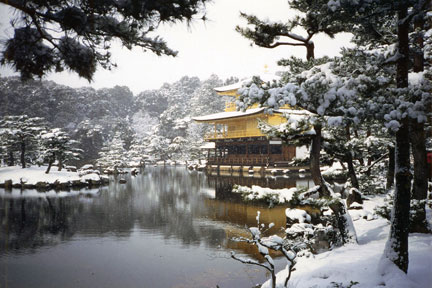
Kinkaku-ji or the Golden Pavillion in the snow, Kyoto
Shiro Nakane of Nakane and Associates spoke at PNCA on Tuesday night. In an excellent lecture that was co-sponsored with the Portland Japanese Garden, his talk was called "Honoring the Past and Envisioning the Future" and was the last part of the PNCA + Five: Idea Studios program for this year. It was a privilege to get an introduction to the design of Japanese gardens by the preeminent landscape architect of our time whose family has actually restored some of the most prominent gardens in Japan. It is hard to find a western equivalent for the temples and gardens of Kyoto and Mr. Nakane's role in their restoration. The closest I could think of would be if the cathedrals of Western Europe were somehow all within walking distance to one another in a small town and his family has been responsible for not only the restoration of the older ones but also the construction of new cathedrals as well.
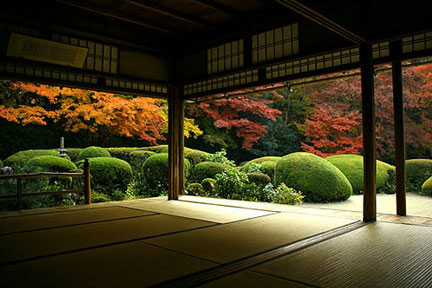
Shisen-do in Kyoto demonstrating the relationship between the interior and exterior spaces
Mr. Nakane's introduction to the Japanese garden was extraordinary. He isolated what seemed to be three major themes in the design of gardens. The first was the integration of the inside and outside. Japanese gardens are separated by thin Shoji doors that can be opened to allow the interior space of the temple to be extended into the garden outside. The garden is an essential part of the experience of living in these temples. As he said "We Japanese live with the rhythms and cycles of the natural world." Second, there is the desire for the major landmark elements, like Mt. Fuji, to be symbolically recreated in the form of the garden. He showed slides of a garden that he has recently completed that echoed Niagara Falls. He also showed a slides of some scrolls from the 11th century that were about the secret teachings of garden design. The scrolls were described as a memory of how nature presented itself and how the garden designer should always learn as much as possible from nature. As I understood it, the third theme is a bit more subtle but was the implied relationship between the microcosm and macrocosm. The microcosm might be the actual physical size of the garden and the size of the plants. It is everything that could be measured with a tape measure. The macrocosm is the way the garden is perceived by the viewer and might suggest something much larger. The result is that you can have an extremely large landscape in a very small space. An example of this would be at Daisen-in where a rock resembles a boat and the small graveled courtyard suggests a vast ocean. As we experience the garden, we are constantly moving between the two polarities of large and small.
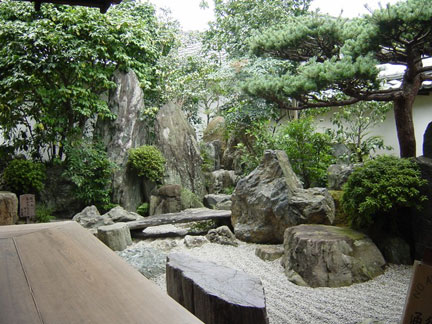
Daitoku-ji subtemple Daisen-in, Kyoto
Mr. Nakane is following in the footsteps of his father who also designed and restored gardens in Kyoto. His father restored some of the most famous Zen gardens in the world, including Ryoan-ji, Saiho-ji and Kinkaku-ji. I was impressed that when the Nakanes were asked to a restore a garden, they looked at the way the garden has changed over hundreds of years as it was recorded in books and drawings. A central concept to the design of a Japanese garden is the concept of the "borrowed view." It is the way that the garden incorporates nearby mountains or trees in the design of the garden. The surrounding views of the garden are sometimes as important as what is created by the garden designer. In one of Mr. Nakane's gardens, one of his clients purchased the whole side of a mountain to protect the borrowed view of the mountain forever. These gardens are designed to last hundreds, if not thousands, of years. While under the right conditions the stones might not change very much during that period, even the best cared for plants live for only a fraction of that time. Plants simply do not live as long as rocks. Over time, as the plants grow, eventually die and new plants begin the cycle again, the experience of the garden subtly changes. For example Ryoan-ji, probably the most famous Zen garden, or as the Japanese would say karesansui (dry landscape garden), was famous in the 15th century for a cherry tree that used to bloom every spring in the courtyard. Today it is famous for the extraordinary arrangement of its stones. Even more amazing is that these gardens are old enough that you compare the experience of the present garden to how it was 50 or 100, and in some cases even 400 years ago. In other words, as Willem De kooning said, they have to change to stay the same.
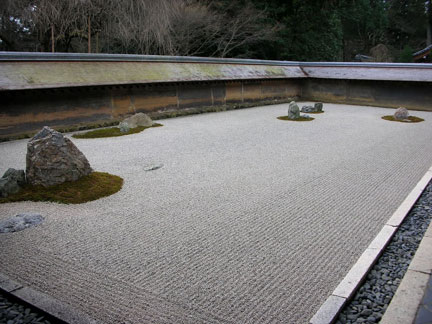
The karesansui of Ryoan-ji, Kyoto
The lesson for me was that if you understand and are respectful toward the history and the intentions of a place, then there is no need to fear change. Mr. Nakane even went further and said that "A garden is an object to be changed." A garden is a dynamic environment so change is inevitable. Every garden exists between the patterns and cycles of the natural world. There is the gentle cycle of day and night as well as the different weather patterns between the more dramatic changes of the seasons. The garden designer is able to collect and focus the energy of these patterns so that it reveals something essential about the experience of the garden. The garden designer strives for harmony above all else. Mr. Nakane's father made the decision to change the sand at Ryoan-ji to the gravel that we see today. The lines that are raked into the garden are softened by the larger size and texture of the gravel. It is a subtle change that makes a huge perceptual difference. His father also restored the gardens at Daisen-in, where he also changed the moss ground cover to a field of moss to suggest an ocean and the garden. At Saiho-ji and Kinkaku-ji, which were both restored by Mr. Nakane's father, they were able to learn some very old techniques in constructing a garden.
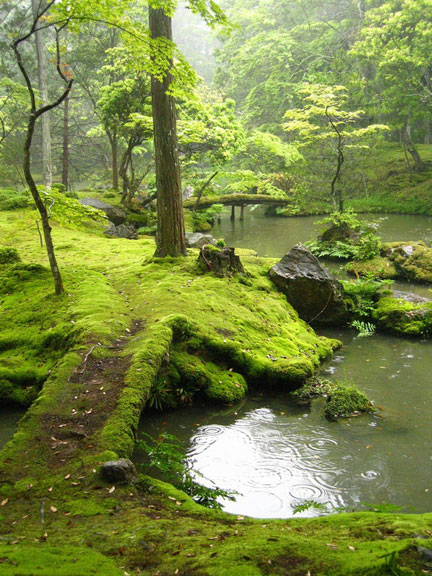
Saiho-ji or the Moss Temple, Kyoto
Mr. Nakane is a great advocate of traditional techniques of garden construction. It is important to realize that everything is designed in a Japanese garden. Even though everything looks natural in a garden, nothing is natural. He learned that at Saiho-ji wood logs and sticks were used to support some of the rock arrangements. Wood will easily rot in a few years when it is exposed to continuous wet and dry cycles that might exist on the edge of a pond. He was reminded that if a piece of wood is entirely submerged in mud or water, as it is at Saiho-ji, it will probably last for a thousand years. In a funny exchange, he talked about a Japanese contractor who had used concrete under water in one project and had thereby "lost honor" because the rock arrangement would only last for 50 to 100 years that way. The techniques of the older garden designers not only work better because they will last for a long time, but also they are ecologically sound in that they use local, natural materials. At the Sento Imperial Palace in Kyoto, his assistants removed, counted, cleaned and replaced by hand approximately 153,000 stones along the edge of a lake in the middle of the garden. He then commented that he thought the quality in the garden was not up to usual imperial standards because it was made for a retired rather than current Emperor.
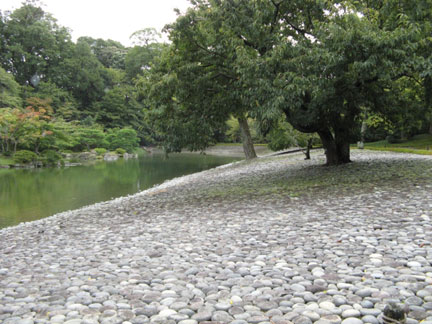
A few of the 153,000 stones that were cleaned and replaced by Mr. Nakane's assistants
at the Sento Imperial Palace, Kyoto
It was amazing to see the slides of the restoration of these magnificent gardens. Ultimately, it is the job of the Japanese garden designer to become invisible. It is ironic that even though Mr. Nakane is one of the best garden designers in the world, if he does his job correctly, his work becomes invisible in the sense that it looks like it was made by nature. There is an amazing amount of modesty and humility that such incredible skill, time and labor are expended, yet they are invisible in the final result because it looks completely natural. His gardens are designed to last hundreds of years. Even more remarkable is that most buildings look best when they are brand new. Gardens on the other hand, really do not find their form until five or ten years after completion. He was very adamant that the quality of the present will influence the future. He said that we need to have quality in the present if we are going to inspire younger generations to create quality in the future. These ideas are just a few of the highlights of the lecture. It was a great honor to be given an introduction to the design of Japanese gardens by one of its most accomplished masters.
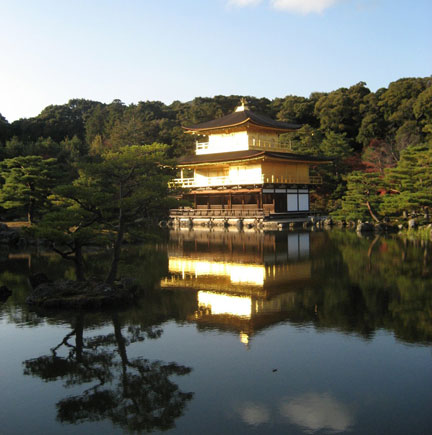
Kinkaku-ji or the Golden Pavillion in the Summer, Kyoto
Great post, Arcy. I suspect Nakane was not easy to grasp by everyone in the audience because of his humble, non-pedantic style of presentation. I'll admit I had to snap my brain into reorganizing his comments along very linear Western lines to create a thread I could follow. And it was worth the effort!
Nice, Arcy.
It really was fascinating to see these world renowned sites commented on so knowledgeably (and so casually, as in "...and then my father and I worked on Kinkaku-ji..."). You've pulled the themes together very nicely and your comment on the Ryoan-ji work, "a subtle change that makes a huge perceptual difference," speaks volumes about the subject matter and the lecture as well.
arcy,
that's some in depth analysis, sir. wish you'd have been giving the lecture. though reading this and talking with you after the event has given me a much better understanding and appreciation of nakane's art. it's pretty phenomenal work. and very cool seeing the landscape sensei in person.
speaking of landscapes, you should pop down to eugene and the white lotus gallery. they're having a landscape show and my bro, jnewton, has a couple of killer pieces in it.
cheers.
Thank you this post, those of us who could not make the talk appreciate it.
One minor discrepancy: the second photo is not of Katsura, but of Shisen-do in Kyoto.



























![[TypeKey Profile Page]](http://www.portlandart.net/nav-commenters.gif)